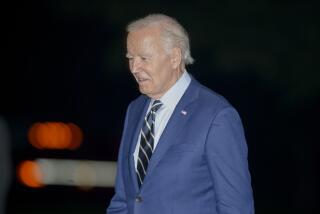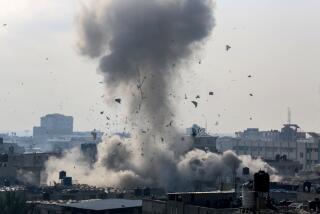U.S.-Iran thaw began with months of secret meetings
WASHINGTON — In mid-March, a small team of U.S. officials boarded a military plane and flew to the tiny Persian Gulf sultanate of Oman on a diplomatic mission so sensitive — and risky — that only President Obama and his closest advisors knew about it.
In a secret encounter arranged by the longtime monarch, Sultan Qaboos bin Said, the Americans sat down with a delegation of Iranian diplomats and nuclear experts in the capital city, Muscat, an ancient trading port on the Arabian Sea.
It was the first in a series of at least five clandestine meetings this year between U.S. and Iranian officials in Oman and elsewhere after more than three decades of bitter estrangement. They paved the way for the landmark agreement announced early Sunday in Geneva designed to freeze Iran’s nuclear program for six months while negotiators seek a more comprehensive pact.
The hidden effort was a gamble by Obama, who promised when he took office in 2009 to engage Iran in the hope of deterring it from developing a nuclear weapon. His early outreach was spurned by the government of arch-conservative President Mahmoud Ahmadinejad, but as U.S.-led sanctions increasingly choked Iran’s economy, the leadership in Tehran apparently reconsidered.
Although the secret talks began in Ahmadinejad’s final months as president, they accelerated after Hassan Rouhani, a moderate cleric, was elected president in June and pledged to take actions to ease the global sanctions.
The back-channel talks were so delicate that Obama did not inform key U.S. allies — not other members of the six-nation diplomatic bloc negotiating with Iran, and not Israel — until late September, after Rouhani gave what many viewed as conciliatory remarks at the United Nations General Assembly in New York.
“When President Rouhani was elected and indicated a new direction, we decided to take that seriously and to test it,” said a senior administration official who briefed reporters on condition of anonymity. Another U.S. official later provided more details about the secret diplomacy, which was first reported by the Associated Press shortly after the Iran deal was announced.
The efforts to conceal the talks continued during the formal nuclear negotiations in Geneva this month when the two key U.S. officials involved, Deputy Secretary of State William J. Burns and Jake Sullivan, Vice President Joe Biden’s foreign policy advisor, flew to Geneva but were not listed on the official roster of delegates.
To hide them from reporters, the State Department housed Burns and Sullivan at a different hotel from the rest of the U.S. delegation and shuttled them to and from meetings via back entrances and service elevators, the U.S. official said.
The official described the early meetings as “crucial” to hammering out the framework of the interim deal announced Sunday, and said they reflected Obama’s desire to seek a diplomatic resolution to the nuclear standoff with Iran.
When Obama was first elected president, Qaboos, a shrewd leader who enjoys good relations with both Washington and Tehran, had volunteered to serve as the go-between, as long as his role was protected.
Back in 2009, according to a secret State Department cable published by the anti-secrecy website WikiLeaks, Oman offered to serve “as both an organizer and a venue for any meeting the U.S. would want with Iran — if kept quiet.”
Two years later, Qaboos’ intervention helped secure the release of three Americans who were detained in Iran after crossing the border from Iraq. That gave Obama administration officials hope that the sultan’s back channel could bear fruit.
In 2011, U.S. officials sat down with an Iranian team in Muscat with the modest aim of exploring whether bilateral talks were even possible.
By early this year, sanctions on Iran’s oil industry, financial sector and banking were causing increasing pain. For the first time, the leaders in Tehran, including supreme leader Ayatollah Ali Khamenei, appeared interested in pursuing a deal with the West.
The first meeting in March quickly led to others. In May, Secretary of State John F. Kerry visited Oman under the guise of pursuing a military deal with Qaboos. His main goal, officials said Sunday, was to discuss how to keep the secret diplomacy working as Iran geared up for presidential elections.
After Rouhani took office in August, Obama sent a letter of congratulations and Rouhani replied. The Iranian leader said of the exchange on NBC News, “It could be subtle and tiny steps for a very important future.”
That month, Qaboos flew to Tehran for a visit that Iranian newspapers said was aimed at facilitating talks between U.S. and Iranian officials — talks that were, by then, secretly well underway.
Burns, Sullivan and a small team of U.S. technical experts had held two more meetings with Iranian officials shortly after Rouhani’s inauguration, and held another two meetings in October, where the outlines of the deal began to take shape.
Administration officials would not disclose the locations of the meetings or the identities of the Iranians involved except to say that they were veteran officials who spoke fluent English.
While the secret talks were going on, Obama and Rouhani took public steps that signaled a potential thaw in relations.
At the U.N. General Assembly in September, Burns and Sullivan came close to arranging a highly symbolic face-to-face encounter between the two leaders, but the Iranians withdrew at the last minute.
Days later, Obama spoke to Rouhani for 15 minutes by telephone in the first direct contact in more than three decades between an American president and his Iranian counterpart.
After that conversation, officials said, Obama began to disclose the outreach effort to other five nations in the group negotiating with Iran — Britain, China, France, Germany and Russia.
Obama informed Israeli Prime Minister Benjamin Netanyahu when they met at the White House on Sept. 30. Officials declined to discuss Netanyahu’s response or other details of the conversation. Netanyahu has been the staunchest opponent of engagement with Iran and denounced the interim nuclear deal Sunday as a “historic mistake.”
More to Read
Sign up for Essential California
The most important California stories and recommendations in your inbox every morning.
You may occasionally receive promotional content from the Los Angeles Times.











